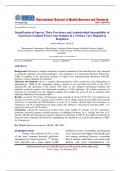International Journal of Health Sciences and Research
www.ijhsr.org ISSN: 2249-9571
Original Research Article
Identification of Species, Their Prevalence and Antimicrobial Susceptibility of
Enterococci Isolated From Urine Samples in a Tertiary Care Hospital in
Bengaluru
Smeeta Huidrom1, Girish N2
1
Demonstrator, Department of Microbiology, Jawaharlal Nehru Institute of Medical Sciences, Imphal.
2
Associate Professor, Department of Microbiology, Vydehi Institute of Medical Sciences and Research Centre,
Bengaluru.
Corresponding Author: Smeeta Huidrom
Received: 20/08/2015 Revised: 14/09/2015 Accepted: 17/09/2015
ABSTRACT
Background: Enterococci, though considered as normal commensal of the intestinal tract, have emerged
as medically important nosocomial pathogens. The emergence of Vancomycin Resistant Enterococci
(VRE) in addition to the increasing incidence of High Level Aminoglycoside Resistance (HLAR),
presents a serious challenge for clinicians.
Materials and Methods: This is a hospital based prospective study carried out in the Department of
Microbiology, VIMS & RC, Bengaluru, during a period of one year from Jan 2013 to Dec 2013.
Identification and speciation of the isolates were done by the standard conventional methods and
antibiotic sensitivity pattern was determined according to CLSI guidelines. All isolates suspicious of
resistance to Vancomycin by disc diffusion method were further put up for E-test to determine their
Minimum Inhibitory Concentration (MIC).
Results: A total of 105 strains of Enterococci were isolated, of which 102 (97.2%) were Enterococcus
faecalis, 02 (01.9%) were E. faecium, and 01 (00.9%) was E. dispar. Enterococcal isolates showed good
sensitivity to Linezolid and Nitrofurantoin. A total of 33 isolates showed high level resistance to
Gentamicin and 39 to Streptomycin by high content disc diffusion. Vancomycin resistance (MIC ≥ 32
μg/ml) was seen in 4 (3.8%) isolates.
Conclusion: Among the enterococcal isolates from urine samples E. faecalis was the commonest.
Antibiotic sensitivity pattern revealed presence of multidrug resistance in E. faecalis and also in E.
faecium, HLAR and Vancomycin resistance. Disparity in detection of VRE by disc diffusion method was
observed when compared with the E-test, highlighting the importance of accurate determination of MIC
for Vancomycin.
Key Words: Enterococcus species, HLAR, VRE, MIC.
INTRODUCTION problem in terms of morbidity and financial
Urinary tract infection (UTI) is one costs, and incur the highest total health care
of the most common bacterial infections cost among urological diseases, exceeding
encountered in clinical practice. [1] Urinary that of chronic renal failure even when renal
tract infections are a major public health dialysis and renal transplantations are
International Journal of Health Sciences & Research (www.ijhsr.org) 90
Vol.5; Issue: 10; October 2015
, included. UTI represents one of the most followed by surgical wound infections and
common diseases encountered in medical bacteremia. [5]
practice today with an estimated 150 million Among enterococcal species, E.
UTIs per annum worldwide. [2] faecalis and E. faecium have been reported
Young, otherwise healthy, women as the two major human pathogens
are commonly affected with an estimated accounting for 85-89% and 10-15% of all
incidence of 0.5-0.7 infections per year. Of enterococcal infections, respectively. [6]
the women affected, 25%–30% go on to The intrinsic antibiotic resistance of
develop recurrent infections not related to Enterococci, coupled with their promiscuity
any functional or anatomical urinary tract in acquisition and dissemination of
abnormality. Although uncomplicated genetically mobile antibiotic resistance
infections do not result in long term elements, presents serious challenges to the
sequelae, for example renal scarring, they treatment of enterococcal infections.
cause significant morbidity, particularly Infections by Enterococci have traditionally
when recurrent. [3] been treated with cell wall active agents
UTIs are commonly caused by (e.g. Penicillin or Ampicillin) in
Enterococci, particularly among hospitalised combination with an aminoglycoside
patients; enterococcal prostatitis and (Streptomycin/Gentamicin); however,
perinephric abscess have also been reported. emergence of High Level Aminoglycoside
Among young healthy women who have not Resistance (HLAR), β lactam antibiotics and
undergone instrumentation, do not have to Vancomycin by some strains has led to
recurrent infections, and do not have failure of synergistic effects of combination
structural abnormalities, Enterococci cause therapy. [5]
<5% of UTIs. In persons who have been Species identification of Enterococci
instrumented, received antibiotics, have may be useful both as an epidemiologic tool
structural abnormalities, and/or have in the investigation of outbreaks of
recurrent UTIs, the rate of urinary nosocomial infections and for clinical
colonisation and infection by Enterococci decisions about therapy because
rises. [4] antimicrobial susceptibility may vary with
The genus Enterococcus consists of species; especially E. faecium and other
Gram-positive, facultative anaerobic species tend to be more resistant than E.
organisms that are ovoid in shape and may faecalis to several commonly used
appear on smears in short chains, in pairs or antimicrobial agents. [5]
as single cells. [4] There is thus a need in tertiary care
Enterococci, though commensal in hospitals to identify, isolate and speciate
adult faeces are important nosocomial Enterococci, for better understanding of
pathogens. Prior to the 1990s, Enterococci their role in infections. Hence, the present
have been recognised as an important cause study was undertaken to isolate, identify and
of bacterial endocarditis for almost a speciate Enterococci and analyse their
century. However, more recently they have antibiotic susceptibility pattern.
been recognised as a cause of nosocomial
infections and "superinfection" in patients MATERIALS AND METHODS
receiving antimicrobial agents. The most The present study was carried out in
common Enterococci-associated nosocomial the Department of Microbiology, Vydehi
infections are infections of the urinary tract, Institute of Medical Sciences and Research
Centre, Bengaluru, to investigate the
International Journal of Health Sciences & Research (www.ijhsr.org) 91
Vol.5; Issue: 10; October 2015




